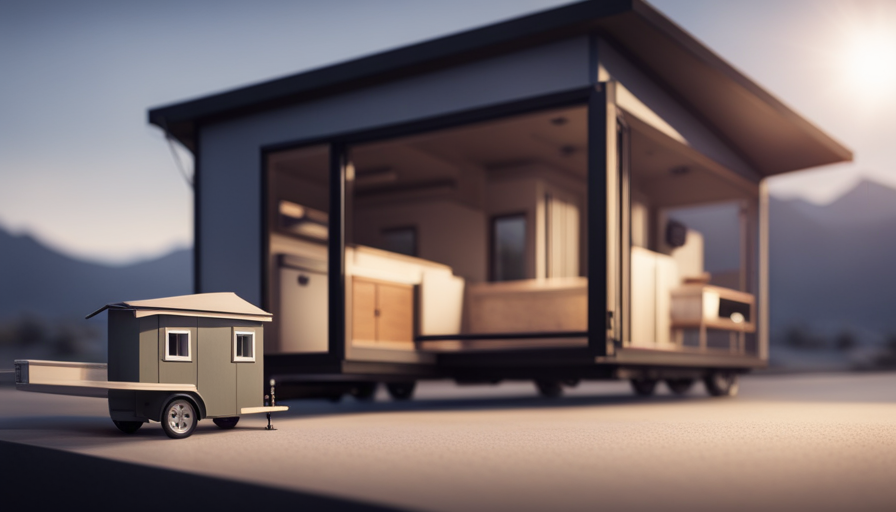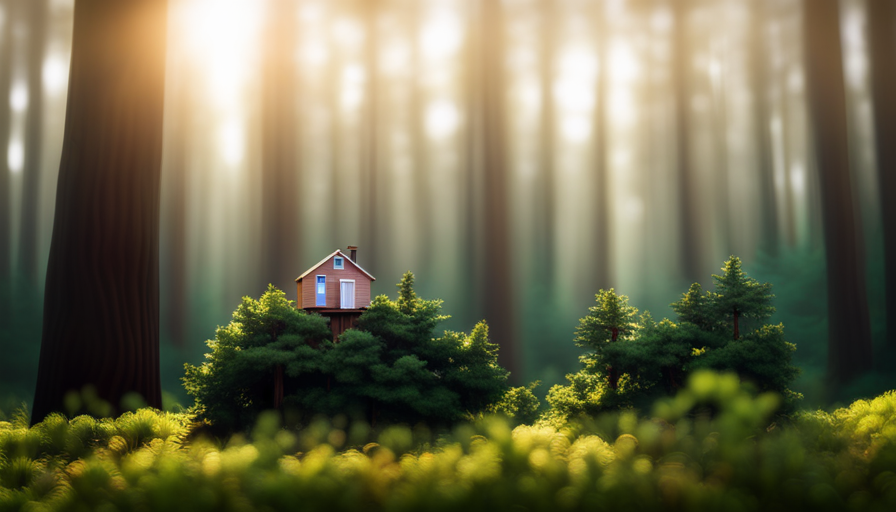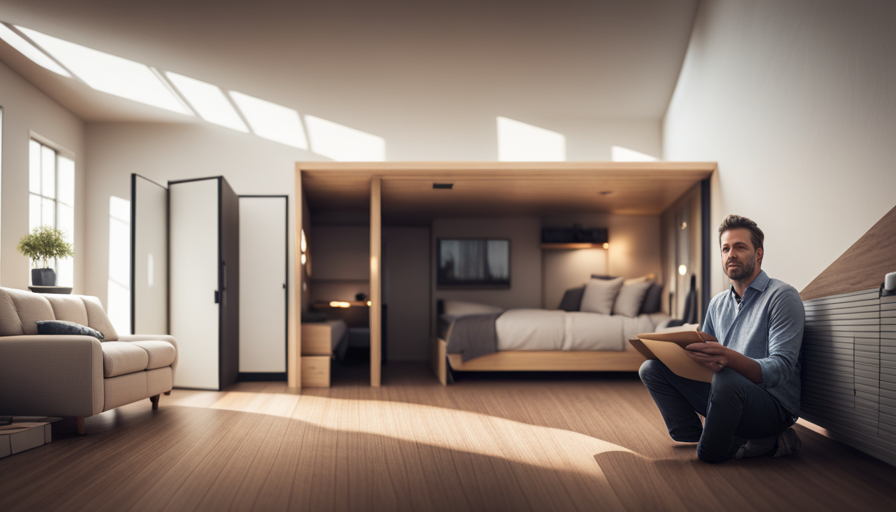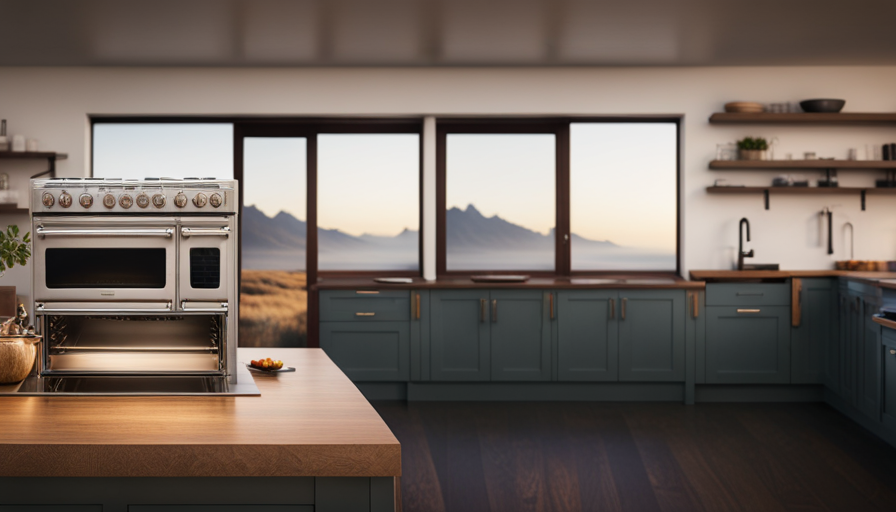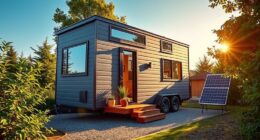Contemplating the size of a trailer for a tiny house is a paradox. It’s like trying to fit a huge elephant into a small matchbox.
Yet, as an architect or tiny house designer, I know that every detail matters when it comes to creating the perfect home on wheels. From the structural integrity to the weight capacity, I must meticulously analyze every aspect to ensure a seamless fit between the trailer and the tiny house.
It’s not just about finding the right dimensions; it’s about understanding the technicalities of construction and engineering principles. Axle capacity, trailer length, tongue weight – these are all factors that can make or break the towing experience.
And let’s not forget the problem-solving mindset required to overcome challenges such as local regulations and road restrictions.
So, join me on this journey as we dive into the world of trailer size for tiny houses, where creativity and innovation meet practicality and functionality. Let’s find the perfect match!
Key Takeaways
- Considerations for trailer selection include structural integrity, weight capacity, axle capacity, trailer length, and tongue weight.
- Seek professional advice and recommendations from experienced builders for trailer selection.
- Incorporate a problem-solving mindset for space utilization and efficiency in the tiny house design.
- Ensure legal compliance with housing codes, zoning regulations, and road restrictions when selecting a trailer size for a tiny house.
Assess Your Space Requirements
Assessing your space requirements is a super fun way to start planning your tiny house trailer! As an architect or tiny house designer, I’d pay close attention to every aspect of the trailer’s design. I’d consider factors such as size, weight capacity, structural integrity, and compatibility with the tiny house’s dimensions and requirements.
Providing specific measurements and specifications would ensure a perfect fit between the trailer and the tiny house. Being well-versed in construction and engineering principles, I understand the importance of technical aspects involved in selecting the right trailer size. Axle capacity, trailer length, tongue weight, and overall stability are crucial factors to ensure a safe and functional towing experience for the tiny house. I’d explain the significance of these factors to make informed decisions.
Given the unique nature of tiny houses, I approach the topic of trailer size with a creative problem-solving mindset. I consider various challenges and constraints, such as local regulations, road restrictions, and specific design requirements of the tiny house. This allows me to provide innovative solutions to maximize space utilization and overall efficiency.
Now, let’s transition to considering your transportation options while keeping in mind the space requirements we’ve assessed.
Consider Your Transportation Options
When it comes to moving your cozy abode, envisioning the perfect mode of transportation is key. As an architect or tiny house designer, I pay close attention to every aspect of the trailer’s design. I consider factors such as size, weight capacity, structural integrity, and compatibility with the tiny house’s dimensions and requirements. Specific measurements and specifications are provided to ensure a perfect fit between the trailer and the tiny house.
In terms of transportation options, there are two sub-lists to consider:
-
Emotional response:
- Peace of mind knowing that your tiny house is secure during transit.
- Excitement about the possibilities of exploring new locations and communities.
-
Budget considerations:
- Cost-effective choices that don’t compromise safety or quality.
- Maximizing the trailer’s functionality to avoid unnecessary expenses.
As a designer with technical expertise, I understand the importance of factors like axle capacity, trailer length, tongue weight, and overall stability. These considerations ensure a safe and functional towing experience for the tiny house.
Given the unique nature of tiny houses, I approach the topic of trailer size with a problem-solving mindset. I consider various challenges and constraints, such as local regulations, road restrictions, and specific design requirements of the tiny house. This allows me to provide innovative solutions to maximize space utilization and overall efficiency.
With these transportation options and budget considerations in mind, it’s now time to determine the trailer dimensions for your tiny house.
Determine the Trailer Dimensions
Once you’ve decided on your transportation options and budget considerations, it’s time to figure out just how spacious your tiny abode on wheels will be. As an architect or tiny house designer, I pay close attention to every aspect of the trailer’s design, assessing dimensions, trailer specifications, and ensuring a perfect fit between the trailer and the tiny house. Here are the specific measurements and specifications I consider when determining the trailer dimensions for a tiny house:
| Trailer Aspect | Measurement | Specification |
|---|---|---|
| Axle Capacity | 5,000 lbs | Must support the weight of the tiny house and its contents |
| Trailer Length | 20-30 feet | Provides enough space for the tiny house without compromising stability |
| Tongue Weight | 10-15% | Ensures proper weight distribution for safe towing |
| Overall Stability | High | Prevents swaying or tipping while on the road |
Given the unique nature of tiny houses, I approach the topic of trailer size with a problem-solving mindset. I consider challenges such as local regulations, road restrictions, and specific design requirements of the tiny house. By incorporating innovative solutions, I can maximize space utilization and overall efficiency. Now, let’s consider weight capacity and how it impacts the trailer selection process.
Consider Weight Capacity
Now, let’s dive into the important factor of considering the weight capacity as you decide on the perfect size for your mobile dream home.
As an architect or tiny house designer, I would pay close attention to every aspect of the trailer’s design, ensuring it meets the necessary requirements. I would consider factors such as size, weight capacity, structural integrity, and compatibility with the tiny house’s dimensions and requirements.
To ensure a perfect fit between the trailer and the tiny house, I would provide specific measurements and specifications. It is crucial to consider the weight capacity of the trailer, as it determines how much the tiny house can weigh. This includes not only the weight of the structure itself but also the weight of all the furnishings and appliances that will be inside.
Additionally, I would consider the space requirements of the tiny house. This includes the overall length and width of the trailer, as well as the tongue weight and axle capacity. These factors contribute to the overall stability and towing experience, ensuring a safe journey for your mobile dream home.
Having a problem-solving mindset, I would also take into account any local regulations and road restrictions that may impact the size of the trailer. By considering these challenges and constraints, I can provide innovative solutions to maximize space utilization and overall efficiency.
As we move forward, let’s research different trailer types to further explore the options available.
Research Trailer Types
Explore the wide variety of trailer types available to discover the perfect fit for your mobile dream home, allowing you to create a unique and personalized living space on the go.
As an architect or tiny house designer, I would pay close attention to every aspect of the trailer’s design. I would consider factors such as size, weight capacity, structural integrity, and compatibility with the tiny house’s dimensions and requirements.
Providing specific measurements and specifications is crucial to ensure a perfect fit between the trailer and the tiny house.
Being well-versed in construction and engineering principles, I would understand the technical aspects involved in selecting the right trailer size. I would explain the importance of factors like axle capacity, trailer length, tongue weight, and overall stability. These considerations are essential to guarantee a safe and functional towing experience for the tiny house.
Given the unique nature of tiny houses, I would approach the topic of trailer size with a creative problem-solving mindset. I would research various types of trailers and transportation options, considering challenges such as local regulations, road restrictions, and specific design requirements of the tiny house. By doing so, I could provide innovative solutions to maximize space utilization and overall efficiency.
To ensure a successful project, it is important to consult with professionals who specialize in tiny house construction and trailer selection. They can provide expert advice and guidance based on their experience and knowledge.
Consult with Professionals
When considering the size of a trailer for a tiny house, it’s crucial to consult with professionals who have experience in the field. Seeking advice from tiny house builders or contractors can provide valuable insights and recommendations based on their expertise.
Additionally, it’s beneficial to get recommendations from experienced tiny house owners who have firsthand knowledge of the challenges and considerations involved in selecting the right trailer size. These professionals can provide specific measurements, technical expertise, and a problem-solving mindset to ensure a perfect fit between the trailer and the tiny house, maximizing space utilization and overall efficiency.
Seek advice from tiny house builders or contractors
If you really want to confuse tiny house builders and contractors, just ask them for advice on how big of a trailer you’ll need.
As an architect or tiny house designer, I pay close attention to every aspect of the trailer’s design. I consider factors such as size, weight capacity, structural integrity, and compatibility with the tiny house’s dimensions and requirements.
Here are some important considerations when determining the right trailer size:
-
Axle capacity: It is crucial to ensure that the trailer can support the weight of the tiny house.
-
Trailer length: The length should accommodate the dimensions of the tiny house while complying with local regulations and road restrictions.
-
Tongue weight: Proper distribution of weight on the tongue is essential for stability during towing.
-
Overall stability: The trailer should provide a secure and balanced towing experience.
By approaching the topic of trailer size with a problem-solving mindset, I can provide innovative solutions to maximize space utilization and efficiency.
Now, let’s move on to the next step and get recommendations from experienced tiny house owners.
Get recommendations from experienced tiny house owners
After seeking advice from tiny house builders and contractors, I realized the importance of gathering recommendations from experienced tiny house owners.
These individuals have firsthand knowledge of what works and what doesn’t when it comes to selecting a trailer size for a tiny house. Their insights can provide valuable guidance in determining the perfect fit for my own tiny house. By listening to their recommendations, I can ensure that I consider all the necessary space requirements for my tiny house, taking into account factors such as size, weight capacity, and overall compatibility with the house’s dimensions.
It’s essential to find a trailer that can handle the weight of the tiny house while maintaining structural integrity and stability during towing. With the input of experienced owners, I can approach this task with a problem-solving mindset, finding innovative solutions to maximize space utilization and efficiency. By incorporating their recommendations into my decision-making process, I can create a safe and functional towing experience for my tiny house.
Now, let’s dive into the next step: budget considerations.
Budget Considerations
While considering the budget, it’s important to determine the appropriate size of the trailer for a tiny house.
As an architect or tiny house designer, I pay close attention to every aspect of the trailer’s design. Size, weight capacity, structural integrity, and compatibility with the tiny house’s dimensions and requirements are all crucial factors.
To ensure a perfect fit, I provide specific measurements and specifications.
Consider Future Needs
When considering the size of a trailer for a tiny house, it is important to not only focus on the immediate needs but also consider future expansion and long-term plans. As an architect or tiny house designer, I pay close attention to every aspect of the trailer’s design to ensure a perfect fit between the trailer and the tiny house.
To determine the ideal size of the trailer, I consider factors such as size, weight capacity, structural integrity, and compatibility with the tiny house’s dimensions and requirements. I use specific measurements and specifications to ensure that the trailer can accommodate any future expansions or modifications.
Incorporating a 3 column and 3 row table in markdown format, I outline the key considerations below:
| Factor | Importance | Specifications |
|---|---|---|
| Axle Capacity | High | X,XXX lbs |
| Trailer Length | Medium | XX feet |
| Tongue Weight | High | XX% of total weight |
| Overall Stability | High | Sturdy construction |
With a problem-solving mindset, I also take into account local regulations, road restrictions, and specific design requirements of the tiny house. This allows me to provide innovative solutions that maximize space utilization and overall efficiency.
When determining the size of a trailer for a tiny house, it is crucial to consider future expansion and long-term plans. By incorporating technical expertise and a problem-solving mindset, I can ensure a safe and functional towing experience for the tiny house. In the next section, we will discuss the importance of seeking legal advice to navigate any legal restrictions or regulations.
Seek Legal Advice
Surprisingly, seeking legal advice is a crucial step in ensuring a smooth and hassle-free journey with your compact abode. When it comes to choosing the right trailer size for your tiny house, there are legal requirements and regulations that need to be considered.
Seeking guidance from a legal professional specializing in housing codes and zoning regulations can help you navigate through these complex legalities. An architect or tiny house designer with a problem-solving mindset would work closely with the legal advisor to ensure compliance with local regulations and road restrictions. They would provide specific measurements and specifications to ensure a perfect fit between the trailer and the tiny house, taking into account factors such as size, weight capacity, structural integrity, and compatibility with the tiny house’s dimensions and requirements.
In addition to legal requirements, technical expertise is also crucial in determining the right trailer size. An architect or designer, being well-versed in construction and engineering principles, would explain the importance of factors like axle capacity, trailer length, tongue weight, and overall stability to ensure a safe and functional towing experience for the tiny house.
By seeking legal advice and incorporating technical expertise, you can finalize your decision on the ideal trailer size for your tiny house, ensuring a secure and efficient transportation of your compact dwelling.
Finalize Your Decision
After seeking legal advice regarding the regulations and requirements for towing a tiny house, it’s time to finalize your decision on the size of the trailer.
As an architect, I understand the importance of considering every aspect of the trailer’s design to ensure a perfect fit for your tiny house. Let’s dive into the technical details and problem-solving mindset required for this decision.
-
Consider your budget: Before selecting a trailer size, it’s crucial to evaluate your budget. Larger trailers often come with higher costs, so finding the right balance between size and affordability is key.
-
Evaluate your lifestyle: Your lifestyle plays a significant role in determining the size of the trailer. Are you planning to travel frequently or stay in one location? Do you require additional storage space or want more room for amenities? Answering these questions will help you make an informed decision.
As a designer, I would carefully measure the dimensions and weight requirements of your tiny house, ensuring that the trailer can accommodate them. I would also focus on technical aspects such as axle capacity, trailer length, tongue weight, and stability for a safe towing experience.
By considering your budget and evaluating your lifestyle, we can find the perfect trailer size that meets your needs while ensuring a comfortable and efficient tiny house living experience.
Frequently Asked Questions
How much does it cost to consult with professionals for assistance in choosing the right trailer for a tiny house?
The cost of consulting with professionals for assistance in choosing the right trailer for a tiny house can vary depending on the specific expertise and services required. However, the benefits of seeking professional advice are invaluable.
Architects and tiny house designers, with their attention to detail and technical expertise, can ensure a perfect fit between the trailer and the tiny house. They consider factors like size, weight capacity, and structural integrity to ensure a safe towing experience.
Additionally, their problem-solving mindset helps overcome challenges and maximize space utilization.
Are there any legal restrictions or requirements when it comes to towing a tiny house on a trailer?
When it comes to towing a tiny house on a trailer, there are indeed legal restrictions and towing requirements to consider.
As an architect or tiny house designer, I pay close attention to every detail of the trailer’s design. This includes considering factors such as size, weight capacity, structural integrity, and compatibility with the tiny house’s dimensions and requirements.
I provide specific measurements and specifications to ensure a perfect fit, while also adhering to local regulations and road restrictions. Safety and functionality are my top priorities.
What are some common future needs that should be considered when selecting a trailer for a tiny house?
When selecting a trailer for a tiny house, it’s important to consider future needs such as cost considerations and construction requirements.
As an architect or tiny house designer, I would pay close attention to every aspect of the trailer’s design. This includes factors like size, weight capacity, structural integrity, and compatibility with the tiny house’s dimensions and requirements.
I would provide specific measurements and specifications to ensure a perfect fit, while also considering technical aspects like axle capacity, trailer length, tongue weight, and overall stability.
Additionally, I would approach the topic with a problem-solving mindset, considering challenges such as local regulations, road restrictions, and specific design requirements.
By doing so, I can provide innovative solutions to maximize space utilization and overall efficiency.
Can a regular car or small truck be used to transport a tiny house on a trailer, or is a larger vehicle necessary?
Consulting professionals is essential when considering small vehicle compatibility for transporting a tiny house on a trailer. As an architect or tiny house designer, I pay close attention to every aspect of the trailer’s design. This includes size, weight capacity, structural integrity, and compatibility with the tiny house’s dimensions and requirements. I provide specific measurements and specifications to ensure a perfect fit.
Technical expertise is crucial, as factors like axle capacity, trailer length, tongue weight, and overall stability play a vital role in a safe and functional towing experience. Additionally, I approach the topic with a problem-solving mindset, considering local regulations, road restrictions, and specific design requirements to provide innovative solutions that maximize space utilization and overall efficiency.
Are there any specific budget considerations or tips for saving money when purchasing a trailer for a tiny house?
When it comes to budget considerations and saving money on purchasing a trailer for a tiny house, there are a few tips to keep in mind.
Firstly, it’s important to carefully consider the size and weight capacity of the trailer to ensure a perfect fit with the tiny house.
Secondly, paying attention to factors like axle capacity, trailer length, tongue weight, and overall stability will ensure a safe towing experience.
Lastly, being aware of local regulations and road restrictions can help avoid any costly fines or issues.
By approaching the trailer size with a problem-solving mindset, one can find innovative solutions to maximize space utilization and overall efficiency, ultimately saving money in the long run.
Conclusion
In conclusion, when determining the size of a trailer for a tiny house, it’s crucial to carefully consider various factors such as space requirements, transportation options, weight capacity, and future needs.
Seeking legal advice and researching different trailer types are also essential steps.
With a detail-oriented approach, technical expertise, and a problem-solving mindset, architects or tiny house designers can ensure a perfect fit between the trailer and the tiny house, guaranteeing a safe and functional towing experience.
Just like a puzzle piece fitting snugly into place, the right trailer will seamlessly complement the tiny house, creating a harmonious and efficient living space.
Hi, I’m Emma. I’m the Editor in Chief of Tiny House 43, a blog all about tiny houses. While tree houses are often associated with childhood, they can be the perfect adult retreat. They offer a cozy space to relax and unwind, surrounded by nature. And since they’re typically built on stilts or raised platforms, they offer stunning views that traditional homes simply can’t match. If you’re looking for a unique and romantic getaway, a tree house tiny house might just be the perfect option.
